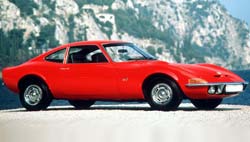












1968 Opel GT |
||
| Classic and Hot Rod Cars And Their Stories | ||
|
|
||
| 1968 Opel GT | ||
"Only Flying is More Exciting" - this slogan become a classic in advertising history, and even an everyday saying in German speaking countries. It belonged to a car which has itself long since become a classic, the Opel GT. Its career got off to a flying start in 1965 when, to everyone's surprise Opel presented an aerodynamic "Experimental Concept" at the IAA in Frankfurt. In view of the sensational design, it was no surprise to see the production version on the road three years later, Opel had set a precedent. For the first time in Europe, a vehicle went into production that had initially debuted as a concept car. The design was very eye-catching; it bore resemblance to the Chevrolet Corvette since it was styled by GM stylists Clare McKichan while working for Opel in Russelsheim, Germany. The 1968 Opel Coupe could not deny a certain similarity to the legendary 1968 American Corvette, nor did it want to. It followed a new design style called the "Coke Bottle Shape", which was also used in the Stingray and like the Stingray had no external trunk lid. "Besides having a fantastic look, the Opel sports car was primarily designed to impress with sophisticated aerodynamics, "explains Erhard Schnell, GT designer at the time. A sleek front end with retractable head lamps that rotate on the longitudinal axis by means of a manual cockpit lever, broad front fenders, tapered flanks in the door area, then bulky rear fenders which flow into the rear with sharp separating edges and roundl amps- these were the Opel GT's key design characteristics. Production of the Opel GT began in 1968 and continued until 1973 with a total of 103,463 produced, 85 percent of the entire GT production run was exported, and 70,222 units (around 70 percent) went to the USA alone. The first few hundred were hand built. The standard engine was the 1.1 liter OHV four-cylinder engine that produced 67 horsepower (SAE). An optional 90 (SAE) horsepower, 1.9 liter engine was offered and was the choice of most buyers. The standard transmission was a four-speed manual but a three-speed unit was available with the 1.9-liter engine. Space for the 1.9- liter engine was so small that the hood had to be power domed and the cylinder- head cover skewed in the front section, the power dome wasn’t just for show. The front engine design sent power to the rear wheels, the chassis was a steel unibody construction. The front suspension was a double A-arms and transverse leaf springs while the rear was comprised of coil springs and a live axle. Front disc brakes and rear drums stopped it quickly. "Safety belts are standard, please buckle up" was the Opel advertisement that promised GT occupants outstanding acceleration. The driving performance the sporty 90 hp two- seater offered was truly top class in the late 1960s. Its 1.9- liter engine accelerated the GT from zero to 100 KPH (62 MPH) in 10.8 seconds, and on to a top speed of 185 KPH (115 MPH), 40 years ago this was considered really fast. The 200 KPH (124 MPH) threshold was like the sound barrier, having just been crossed by European muscle cars of that generation such as the Mercedes 280SE 3.5 with a 200hp V8 engine. A Porsche 912 with four cylinders and 90hp just like the Opel GT also had a top speed of 185km/h, but was 1.7 seconds slower from zero to 100 KPH. Several reasons led to the end of production in August 1973, including demands from the USA, "the most important export market" to fit bulky safety bumpers into the design which did not match the style of the car Opel had created. Brisonneau & Lotz was bought by Renault signaling the end of the contractual relationship with Opel. |
||
Note: All Images And Stories On This Site Are Copywrited. Use Of Any |
||
 Great Pricing & Selection of Cameras and Accessories: Top Camera Mall |
||
|
||

